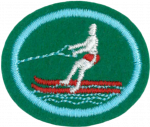Especialidades JA/Esquí acuático/Respuestas
| Esquí acuático | ||
|---|---|---|
| Asociación General
|
Destreza: 2 Año de introducción: 1961 |
|
Requisitos
|
La especialidad de Esquí acuático es un componente de la Maestría Acuática. |
1
Véase Natación II para consejos e instrucciones.
2
2a
2b
2c
2d
2e
2f
2g
2h
2i
2j
2k
3
3a
3b
3c
3d
3e
3f
4
Practice, practice, practice. You should really have an instructor for this honor.
5
This means cross the wakes without falling in the water. A good demonstration of the results of your practice.
6
6a
6b
In an attempt to become as agile as possible, slalom waterskiers use only one ski with feet oriented forward, one in front of the other. Slalom skis are narrow and long, at 57–70 inches (145–178 cm) depending on the height and weight of the skier. The two forward-facing bindings vary: they can be made of rubber or thick plastic, and they can be designed more like a snow ski binding or more like a roller blade boot.
6c
Trick skiing uses small, oval-shaped waterskis. Beginners use two skis until ready to switch to one ski. The shorter, wider trick ski has a front binding facing forward and a back binding facing at a 45°. It has a smooth bottom that allows it to turn over the surface of the water. According to official 2013 Tournament Rules for 3-event competition in the United States and the Pan-Am Games, skis used in the Tricks event must be a single ski without fins, although molded rails/grooves less than 1/4" are allowed, as are a foot pad cemented to the ski as a place for the rear foot; in addition, the ski must float with all bindings, fins, etc., installed. The trick ski's configuration allows performance of both surface and air tricks in quick succession with enough practice and training.
6d
A kneeboard is a buoyant covex board similar to a surf board oen which the kneeboarder kneels. A boat is used to tow while the boarder hange on to the towrope. Some kneeboards have fins and some do not for increased maneuverability. Most use velcro straps to secure the knees.
References
- Hand Signals and Safety (California) http://www.dbw.ca.gov/Pubs/Watski/INDEX.HTM
- http://en.m.wikipedia.org/wiki/Waterskiing
- Categoría: Tiene imagen de insignia
- Categoría:Libro de Respuestas de Especialidades JA/Especialidades
- Categoría:Libro de Respuestas de Especialidades JA
- Categoría:Libro de Respuestas de Especialidades JA/Nivel de Destreza 2
- Categoría: Libro de respuestas de especialidades JA/Especialidades introducidas en 1961
- Categoría:Libro de Respuestas de Especialidades JA/Asociación General
- Adventist Youth Honors Answer Book/Recreation/es
- Adventist Youth Honors Answer Book/Recreation/Primary/es
- Categoría:Libro de Respuestas de Especialidades JA/Etapa 0
- Adventist Youth Honors Answer Book/Aquatic Master Award/es
- Adventist Youth Honors Answer Book/Prerequisite/Swimming - Intermediate/es
- Adventist Youth Honors Answer Book

